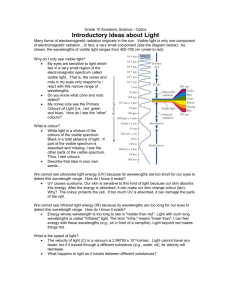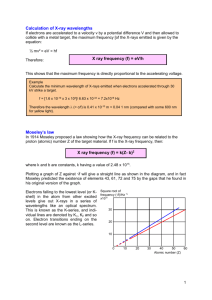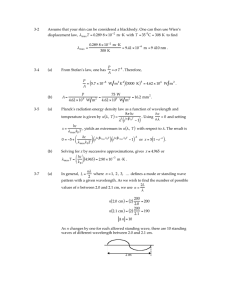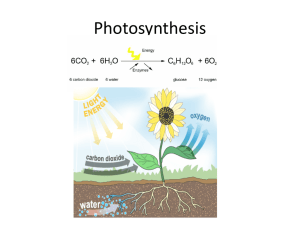To be presented at IEEE/LEOS Summer ... Access Networks, August 1992, Santa Barbara, ...
advertisement
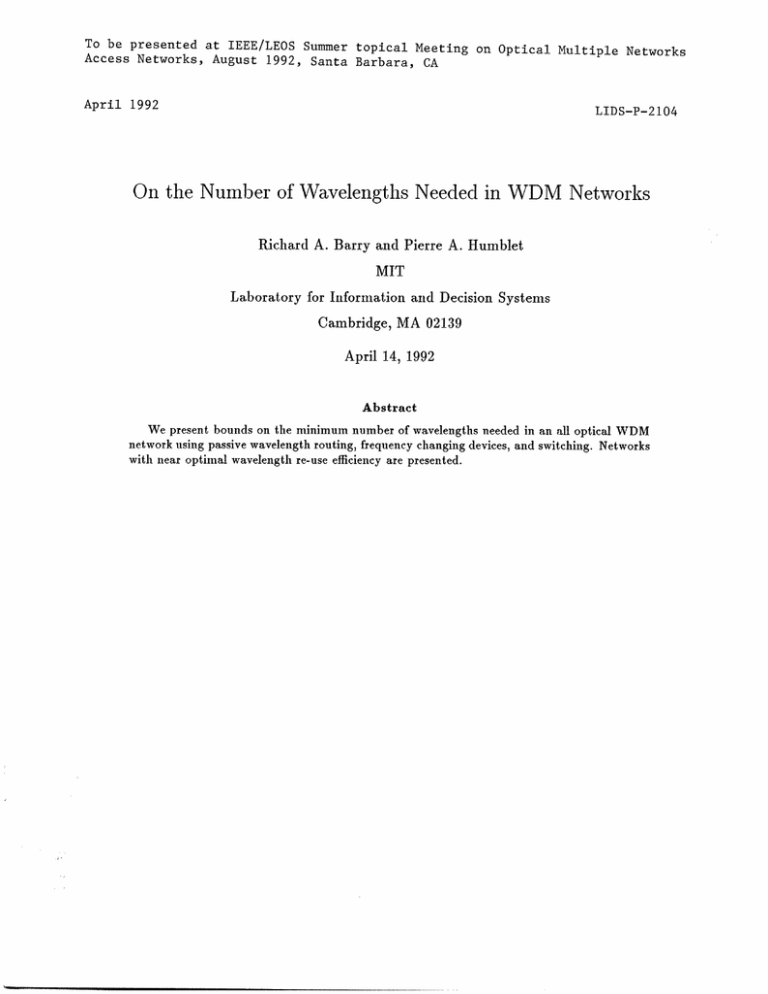
To be presented at IEEE/LEOS Summer topical Meeting on Optical Multiple Networks
Access Networks, August 1992, Santa Barbara, CA
April 1992
LIDS-P-2104
On the Number of Wavelengths Needed in WDM Networks
Richard A. Barry and Pierre A. Humblet
MIT
Laboratory for Information and Decision Systems
Cambridge, MA 02139
April 14, 1992
Abstract
We present bounds on the minimum number of wavelengths needed in an all optical WDM
network using passive wavelength routing, frequency changing devices, and switching. Networks
with near optimal wavelength re-use efficiency are presented.
Bounds on the Number of Wavelengths Needed in WDM Networks l
Richard A. Barry and Pierre A. Humblet
MIT, Laboratory for Information and Decision Systems
Cambridge, MA 02139
1
Introduction
Consider the all optical network (AON) shown in Fig. la. The A-nodes selectively route the signals on
the input links to the output links based on wavelength only. We assume that the A-nodes cannot be
reconfigured, thus if there is a path from transmitter n to receiver mn on wavelength A, there is always
such a path even if there is no traffic between n and nm. Paths for three wavelengths, Red, Green, and
Blue are shown in Fig. lb. The only freedom, after the network topology (fig. la) and wavelength paths
(fig. lb) have been determined, is in the tuning of the transmitters and receivers. Note that this network
can support any matching of the transmitters to two of the receivers (with no multi-casting) except the
matching T = {(1, B), (2, C)}. The reason being that (1, B) and (2, C) must both use Red simultaneously.
Since there is a path from 2 to B on Red, the two sessions collide at receiver B. This does not happen
for any other pair.
In section 2, we present a lower bound on the number of wavelengths required to avoid collisions.
This bound holds for any network topology with A-routing and wavelength changing devices. We do not
restrict ourselves, as we did in the example above, to traffics without multicasting.
We will see that for very large networks, > 106 users, A-routing cannot provide full connectivity
without some possibility of collisions. A-routing can be combined with conventional circuit switching to
produce networks of the type proposed by Stern [3]. In these networks, the A-paths are reconfigurable.
In section 3, we present a lower bound on the number of switching states required for a network with
1A users and F wavelengths. We show that unless F v/, the number of switching states cannot be
dramatically reduced from that of a conventional circuit switched network (F=l).
2
A Bound on the Required Number of Wavelengths
Let s = (n, mn) be a session, where n is a transmitter and m is a receiver. A traffic, T , is defined as a
set of sessions. A receiver can be active in at most one session of a Traffic. A transmitter is permitted
to be active in more than one session (multicasting). A traffic set, T, is a set of traffics. The traffics,
T E T are the allowable traffics. Let F(T) be the minimum number of wavelengths for any switchless
AON needed to support T without contention. Then, we will show that
F(T) >
[PM
I] )
-1
(1)
where pM is the maximum number of sessions that can be on at any time. 0 < p < 1 is called the
maximum utilization of the network
Using eqn. 1, or variations of it, the number of wavelengths required for different T can be bounded.
Three examples, all with maximum utilization, p = 1, are listed below. Upper bounds are obtained by
construction. In each example, the best bounds known are presented. The last example shows that the
lower bound can be very tight.
Arbitrary: JVM < F(T) < M
Each receiver can be paired with any transmitter.
Permutations: M < F(T)< rM + 2
Arbitrary connections between transmitters and receivers without multicasting [2].
Blocking: M < F(T) < vJ/
Group the transmitters into disjoint sets, T-LANS, of size v/A . Similarly group the receivers into RLANS. Allow at most one active session between any [T-LAN,R-LAN] pair. A typical traffic is shown in
Fig. 2. The upper bound construction can be implemented by making each T-LAN (R-LAN) a broadcast
star.
1lResearclt supported by the Arilmy Iesearch Office
ulnder contract.
DAAL03-86-K-01
l71
1_____________ ______
12 3
_
1 2 3
1 2 3
I
.
1
2 3
F3
2..
3receivers
*> ~~I
2 wavelefigthr ut rs
Redwrar
-*
232 _ __
I
_*
wtr
FOCI
2avelengthPaths
__· _
2
Ir.ran
-
I
I
· _
t-I-I
I-- -
I-I
IrtI......
* e
q~rillser
A
_
1_
Blue
Fig. a,b
3
Fig. 2
Switching States
Now consider an AON with A-routing, wavelength changers, and switches. Let S be the number of
switching states. Then for permutation routing, the number of states is bounded below by
log2 S
>
Mlog2 M-2Mlog 2 F- l.44M
(2)
where F is the number of wavelengths. When F - 1 this agrees with the well known formula for
the minimum complexity of an MxM non-blocking switch [1]. It can be seen that A-routing cannot
dramatically reduce theSnumber
t
e. of switching states unless F
4
Conclusions
Without switches, about F2 users can be supported with F wavelengths with minimal blocking. For
instance, dividing the fiber into 1000, 1 Gbps channels and using A-routing, we can design a partially
blocking network (Fig. 2) with 106 users. The maximum throughput is 1000 Tbps. Instead of blocking,
wavelengths can be shared by using TDMA. In the worst case, 1000 users from one LAN connecting to
1000 users from another LAN, the user data rate is limited to 1 Mbps. It may be possible to design a
switchiess non-blocking fully connected network with F2 users. This is an open question.
For networks with x 108 users, switches will be necessary. The main advantage here of combining
A-routing and switching is to reduce the frequency of changing states. This is because each state can
handle many traffics (up to ; 106! ). This may greatly simplify control of the network.
References
[13 Joseph Y. Hui. Switching and Traffic Theory for Integrated BroadbandNetworks. Kluwer Academic
Publishers, 1990.
[2] Thomas F. Leighton. Introduction to ParallelAlgorithms and Architectures: Arrays, Trees, Hypercubes. Morgan Kaufmann Publishers, 1992.
[3]

